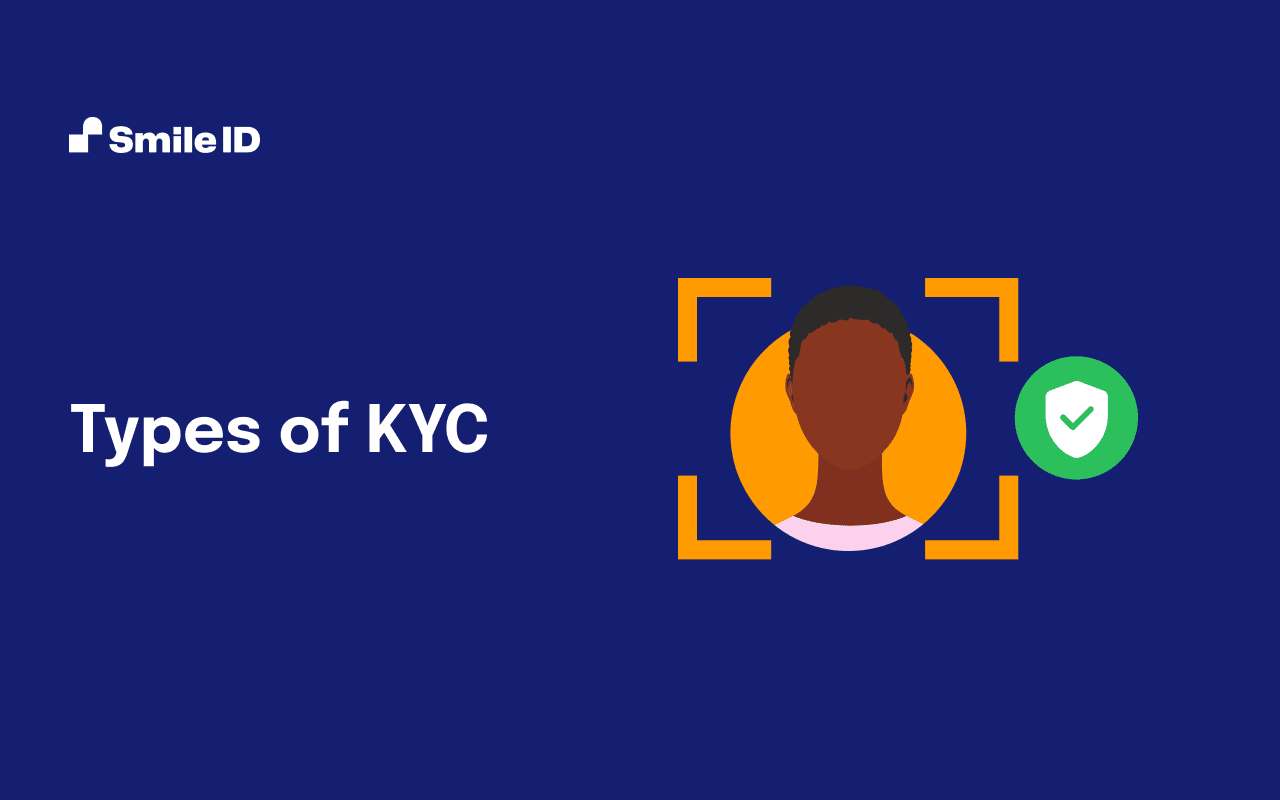With global financial crime predicted to reach $10.5 trillion USD annually by 2025, KYC has never been more important. It is not just about adhering to regulatory requirements; effective KYC procedures safeguard financial systems from money laundering, terrorism financing, and other illicit activities.
KYC refers to the process that organisations—especially in banking and financial services—use to verify the identity of their clients. The methods for conducting KYC vary, ranging from traditional document-based verification to cutting-edge biometric technologies. Each method serves the crucial purpose of ensuring that businesses can confirm the identity of their customers, assess potential risks, and maintain a safe and compliant environment.
This article will explain the various types of KYC methods used today, exploring both traditional and advanced techniques. From document-based checks to biometric and digital onboarding, these verification methods are shaping the future of customer onboarding and fraud prevention.
What is KYC and Why is it Important?
Know Your Customer (KYC) is a process where businesses verify the identity of their clients. This helps ensure customers are who they claim to be. KYC is vital for financial institutions like banks and insurance companies to prevent illegal activities such as money laundering and fraud. Understanding its significance and history can help you grasp why it's crucial in today’s global economy.
Financial institutions use KYC to prevent illegal activities like money laundering and fraud. By verifying customer identities, banks and other institutions can detect suspicious activities early. This process helps them avoid hefty fines and damage to their reputation. KYC involves three main components: Customer Identification Program (CIP), Customer Due Diligence (CDD), and Ongoing Monitoring. Each part plays a critical role in ensuring customer identities are legitimate and transactions are safe.
KYC is important for monitoring the flow of money in the global economy. Requiring businesses to verify customer identities helps track financial movements and prevent illegal money transfers. This protects stakeholders, such as customers and shareholders, from potential financial crimes. Moreover, KYC supports international cooperation by aligning with global standards like those set by the Financial Action Task Force (FATF).
Why is Customer Due Diligence Crucial?
Customer Due Diligence (CDD) is a fundamental part of the KYC process. It ensures that financial institutions know their customers and understand the risks they pose. This is crucial because it helps prevent money laundering, fraud, and other illegal activities. By assessing a customer's risk level, institutions can apply the appropriate level of scrutiny and monitoring. Effective CDD protects the institution and its clients, maintaining trust and security in the financial system.
What are the 3 Categories of KYC?
KYC is divided into three main categories, each playing a vital role in verifying customer identities and preventing illegal activities. These categories ensure that financial institutions conduct thorough checks to maintain trust and security.
a. Customer Identification Program (CIP)
The Customer Identification Program (CIP) is the first step in the KYC process. It involves collecting essential information from customers to verify their identity. CIP requires individuals to provide:
- Legal Documents: Such as a passport, driver's license, or national ID card.
- Personal Information: Including full name, date of birth, address, and identification number.
These details help institutions confirm the identity of their clients. CIP is crucial because it provides a baseline for assessing each customer's risk level. It aligns with global standards, such as those from the Financial Action Task Force (FATF), to prevent financial crimes.
b. Customer Due Diligence (CDD)
Customer Due Diligence (CDD) goes beyond initial identification by evaluating the risks associated with a customer. It involves:
- Assessing Credibility: Institutions gather data to understand the customer's financial history and behaviour.
- Risk Levels: Customers are categorised based on risk, which helps tailor monitoring efforts.
CDD ensures businesses are aware of potential threats posed by their clients. This step is critical to identifying high-risk customers, such as Politically Exposed Persons (PEPs) or those involved in high-value transactions.
c. Ongoing Monitoring
Ongoing Monitoring is the continuous process of reviewing customer transactions and behaviour. This step:
- Detects Suspicious Activities: By monitoring transactions for unusual patterns or high-risk behaviours.
- Updates Risk Profiles: Regularly reassesses customer risk levels based on their financial activities.
Banks and financial institutions use advanced software to automate this monitoring. This helps quickly identify any irregularities or potential threats. Ongoing Monitoring is vital for maintaining compliance with regulations and protecting the institution's reputation. It ensures that any changes in customer behaviour are promptly addressed, reducing the risk of financial crimes.
Types of KYC: Key Verification Methods Explained
Let's take a look at some of the key types of KYC:
1. Digital ID Verification
Digital ID verification allows institutions to verify customer identities using electronic identities issued by governments or trusted third parties. Customers can use their digital IDs to confirm their identities remotely, making it a popular option in regions with established electronic identification systems and frameworks. The document can either be verified for authenticity using a document verification solution or the customer information verified from government databases using a government KYC check solution.
Advantages:
- Remote accessibility: Customers can be verified from any location without needing to present physical documents.
- Speed and efficiency: The verification process is automated, providing near-instant authentication and faster onboarding.
- Security: Digital ID systems often come with built-in encryption and other safeguards to protect sensitive information.
Disadvantages:
- Limited availability: Digital IDs are not universally available, limiting their application to only regions or countries where governments have implemented such systems.
- Reliance on third-party systems: The process depends on external authorities or entities to issue and manage digital IDs, which can lead to bottlenecks.
- Potential for hacking: Digital IDs stored online may be vulnerable to cyber-attacks if not adequately protected.
Best for: Financial institutions with a global customer base or those operating in regions with robust digital ID infrastructures.
2. Physical Document-Based KYC Verification
Document-based KYC is the traditional method of customer verification. It involves submitting and manually reviewing physical identity documents, such as passports, driver's licences, utility bills, and bank statements. Financial institutions then verify these documents to authenticate the individual's identity.
Advantages:
- Widespread familiarity: Document-based KYC is widely understood and accepted across industries.
- Direct verification: It allows for a straightforward, one-on-one comparison of customer details against official documents.
- Legally accepted: It is a mandatory KYC method in many jurisdictions due to its simplicity and transparency.
Disadvantages:
- Time-consuming: This method is slow, requiring manual handling and verification of physical documents and delaying onboarding.
- Prone to errors and fraud: The manual process increases the risk of human error, while counterfeit documents can still be difficult to detect.
- Lack of scalability: As businesses scale, it becomes less efficient to verify each customer manually.
Best for: Small businesses or financial institutions onboarding local customers where face-to-face verification is feasible and compliance is strictly based on local regulations.
3. Biometric KYC Verification
Biometric KYC involves verifying customers through unique physical characteristics such as fingerprints, facial recognition, voice patterns, or iris scans. These traits are captured using digital tools, making the process highly secure and difficult to forge. Biometric KYC is increasingly being adopted due to its ability to enhance security and reduce fraud risk.
Advantages:
- Higher security: Biometric traits are unique to each individual, making them difficult to falsify or manipulate.
- Faster verification: The process can be completed within seconds, making it ideal for large-scale, digital onboarding processes.
- Convenience: Customers can authenticate themselves using their smartphones or computers, enhancing the user experience.
Disadvantages:
- Privacy concerns: Customers may be hesitant to share biometric data due to concerns over misuse or data breaches.
- False negatives/positives: While biometrics are highly accurate, errors can still occur in cases of technical malfunctions or poor-quality scans.
Best for: Large financial institutions or fintech companies that deal with high-risk transactions, need rapid onboarding and require robust security measures to detect fraud.
4. Video KYC Verification
Video KYC is a digital verification method where customers complete a live video call with a KYC officer. During the call, the officer examines the customer’s documents in real-time, asks verification questions, and assesses the individual’s identity. This method became widely adopted during the COVID-19 pandemic, providing a safe and remote alternative to in-person verification.
Advantages:
- Increased security: A live video call adds an additional layer of scrutiny, allowing verification officers to spot inconsistencies or suspicious behaviour.
- Remote and personal: Customers can be verified without having to visit a physical branch, while still maintaining personal interaction with the institution.
- Compliant with regulations: In many countries, video KYC has been officially recognised as a valid KYC method, offering a balance between digital and manual checks.
Disadvantages:
- Resource-intensive: Video KYC requires staff to conduct live interactions, which may increase costs and time spent on each verification.
- Dependence on Internet quality: Both the customer and the institution require a stable Internet connection for the video verification to proceed smoothly.
- Time-consuming for large volumes: While suitable for high-value clients, video KYC can become inefficient for institutions handling high volumes of customer onboarding.
Best for: Institutions that need to verify high-risk or high-net-worth individuals or in regions where face-to-face interaction is required for regulatory compliance but must be done digitally.
However, the invention of AI deep fakes raises questions about the effectiveness of video KYC verification methods today.
Documents Required for KYC
The documents required for KYC verification vary depending on the country, regulatory framework, and type of verification being used. However, the most common documents required include:
i. Proof of Identity:
- Passport
- National ID card
- Driver's licence
- Voter's ID
ii. Proof of Address:
- Utility bills (electricity, water, or gas)
- Bank statements
- Lease agreements
- Government-issued letters
iii. Additional Documents for Enhanced Due Diligence (EDD):
In cases where enhanced verification is needed (e.g., politically exposed persons or high-value transactions), institutions may require:
- Source of funds documentation (bank statements, payslips)
- Business registration documents for corporate clients
- Tax returns
These documents are typically scanned and submitted digitally in modern KYC processes, though they may be physically reviewed in some cases.
Achieving KYC Compliance through Automation with Smile ID
Here’s how Smile ID helps businesses automate their KYC compliance process:
Step 1: Identity Verification
Smile ID offers an array of identity verification solutions to help businesses meet their KYC compliance needs. This includes:
- Document Verification: empowers businesses to verify 8500+ identity documents across 226 countries globally using biometric authentication and OCR technology. Our solution boasts 100% coverage across all African countries with at least 3 ID types covered.
- Government KYC Checks: leverage direct access to databases from ID issuing authorities across Africa to verify customer identity.
- Enhanced Document Verification: Combine the functionality of Document Verification and Government KYC checks in one robust solution for a more detailed compliance check.
Step 2: AML Check
Take extra precautions by running an AML check on the customer against PEP, Sanctions, and watchlists.
Conclusion
As financial institutions continue to face increasing regulatory pressures, adopting the right KYC verification methods is vital to ensuring compliance and protecting against fraud. Each method—document-based, biometric, digital ID, and video KYC—has its own advantages and disadvantages, depending on the institution's needs, customer base, and the jurisdiction in which it operates.
Smile ID solutions are designed to provide you with comprehensive AML and KYC coverage in 54+ countries across Africa. Our APIs and SDKs are designed for easy integration and interaction with your existing infrastructure. Book a free demo today to learn more.


